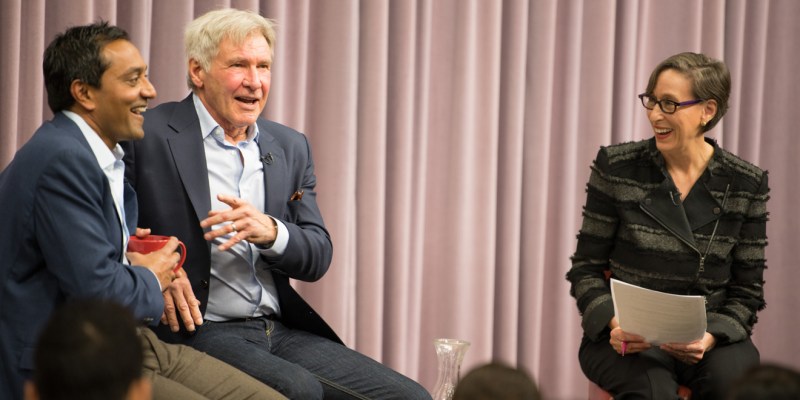Actor and producer Harrison Ford spoke about his environmental conservation work in conversation with M. Sanjayan, CEO of Conservation International (CI), during a surprise visit Wednesday to MS&E 472: Entrepreneurial Thought Leaders Seminar. Tina Seelig, faculty director of the Stanford Technology Ventures Program and MS&E professor, moderated the conversation.
The weekly lecture series, organized by the Stanford Technology Ventures Program, brings entrepreneurs of all fields to share stories of ambition and enterprise with students. Ford was invited to speak as the vice chair of CI, a nonprofit that promotes sustainability with the ultimate goal of preserving nature. He has served on CI’s board of directors for more than 25 years.
Ford described how, when he first started working at CI, the group collected palm nuts and sold them to Patagonia to make buttons.
“We were giving people an economic alternative to unsustainable development,” he said. “That continues to be the model that I think is is most useful.”
Sanjayan added that while some individuals contest the importance of sustainability measures, others believe it to be a pressing issue.
“The folks right now…who are still in denial are doing so willfully,” he said. “There is probably a small percentage of the population who somehow doesn’t really believe it… They are making a choice to ignore what’s right in front of them. And everywhere around the world that I travel, I see leaders…repeatedly emphasize this message that the time is now, sustainability is a real issue we need to deal with.”
Sanjayan pointed to a recent CI project just outside the Kruger National Park as an example of a sustainable intervention.
“If you go to Kruger National Park, you can stay at $2,000 a night lodges,” he explained. “There’s a fence, and right outside the fence there’s the poorest black community in all of South Africa.”
According to Sanjayan, cattle ranchers in the community just outside Kruger faced challenges bringing their meat to market. In response, members of CI created a mobile slaughterhouse to bring the market directly to the cattle. Prior to this intervention, meat had to be imported from as far away as Norway.
“Those community members, for the first time ever this summer, were able to sell their cows,” Sanjayan said.
He added that CI also collaborates with corporate partners to improve the sustainability of their operations, citing Starbucks as an example. Prior to working with CI, 5 percent of Starbucks’ coffee was harvested sustainably. Today, Sanjayan said, that number is close to 100 percent.
“Every drop of coffee you buy at Starbucks [today] comes from a farm where you cannot cut a tree down to grow coffee, you have to send your kid to school if you’re going to sell coffee to Starbucks, and then [follow] a variety of other metrics that include pesticide and water use,” he said. “Starbucks is doing it partly to be a good social citizen, also because there [are] fundamental issues about the land that’s available for coffee growing in Europe. It’s in their own interest to get ahead of it.”
When asked about issues that are difficult to tackle, Ford spoke about the challenge of leveraging movements.
“We spend a lot of time talking about helping to create movement for change, and the problem in my mind is that movements are much more likely to sell t-shirts than they are to make change,” he said. “They very quickly shift. It’s very hard to use a movement to create these specific kinds of activity which are necessary to make the change.”
As a counterexample, Ford turned to speak about a current movement that he believes is spurring action: student activism following last week’s mass shooting at Marjory Stoneman Douglas High School in Florida.
“Part of what [the students are] talking about is so strong emotionally that it cuts across a lot of resistance,” he said. “I’m seeing what I think is a moment where we may begin to address the issue of gun violence because of the passion, and the immediacy of their access to the means of communication, and the way we feel.”
Seelig closed the session by asking Ford and Sanjayan what they wish they had known as students at 20 years old.
“I didn’t really discover my utility in college,” Ford said. “Towards the ends of my college years, I began to understand that what moved me might be potentially useful to me. I found a community in storytelling, and that’s what eventually became my life’s work.”
Contact Rebecca Aydin at raydin ‘at’ stanford.edu. Contact Nicholas Midler at midler ‘at’ stanford.edu.
This article has been updated to reflect that the lecture series was organized by the Stanford Technology Ventures Program.
